Frequently Asked Questions
The permanent makeup industry is constantly evolving. Nano or machine hair strokes have gained popularity over the last few years beacuse they give the same natural looks as Microblading, but they are better for the skin and suitable for all skin types. I have been slowly transitioning to nano/machine hair strokes over for the past few years, and no longer do traditional Microblading. You will see examples of past Microblading in my portfolio but this look is now replaced with Nano hair strokes.
Microblading vs Nano Explained (Video)
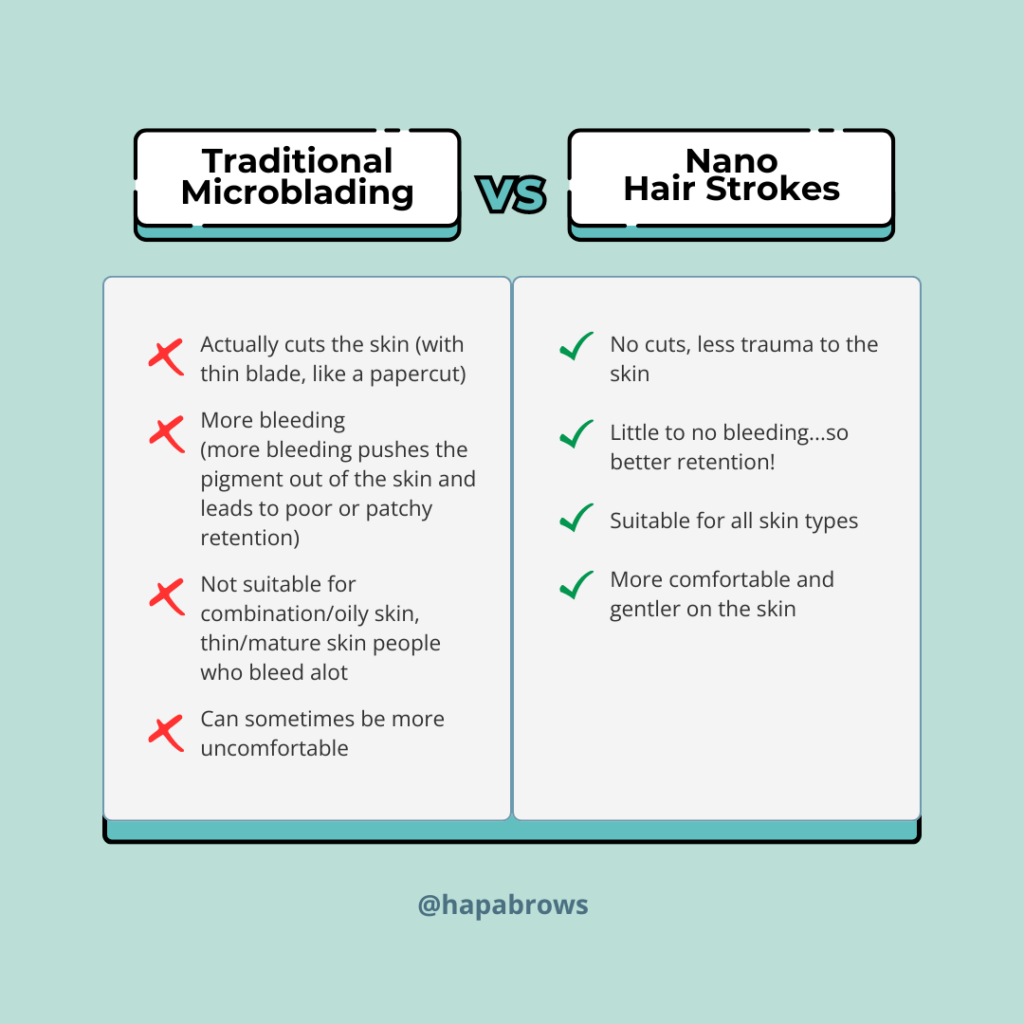
Nano Hair Strokes are hairlike strokes. Shading is the background color or gradient similar to makeup. Nano Hair Strokes is ideal for dry/normal skin types with even sparse hairs, and yields a natural daytime look. Nano Hair Strokes can be done on combination/oily skin types, but hair strokes might fade/blur quicker.
We generally recommend Shading if:
-You wear brow makeup everyday
-You have combination/oily skin
-You have very uneven brow
-You have previous Microblading (done elsewhere) that needs to be color corrected or covered upBook what service you are leaning toward. There is a consult at the beginning of every appointment and to discuss the different styles, your brow goals, and artist’s recommendations. We look at pictures to see what style you gravitate towards. And decide together what style will best fit your brow goals.
If you are on the fence about Nano Hair Strokes only versus the Nanoshading Combo, the best thing is to start slow. You can always add, but you can’t go back. I recommend starting with Nano Hair Strokes if you are nervous/unsure and see how it heals and if it fits your day-to-day needs. Then at the 4-8 week touch up you have the option of adding shading at your touch up appointment if desired/needed. It’s hard to know what you want/need and we try to give you flexibility in figuring out what works for you.
Powder Shading (shading only) is recommended for those who prefer a makeup look and a more defined shape.
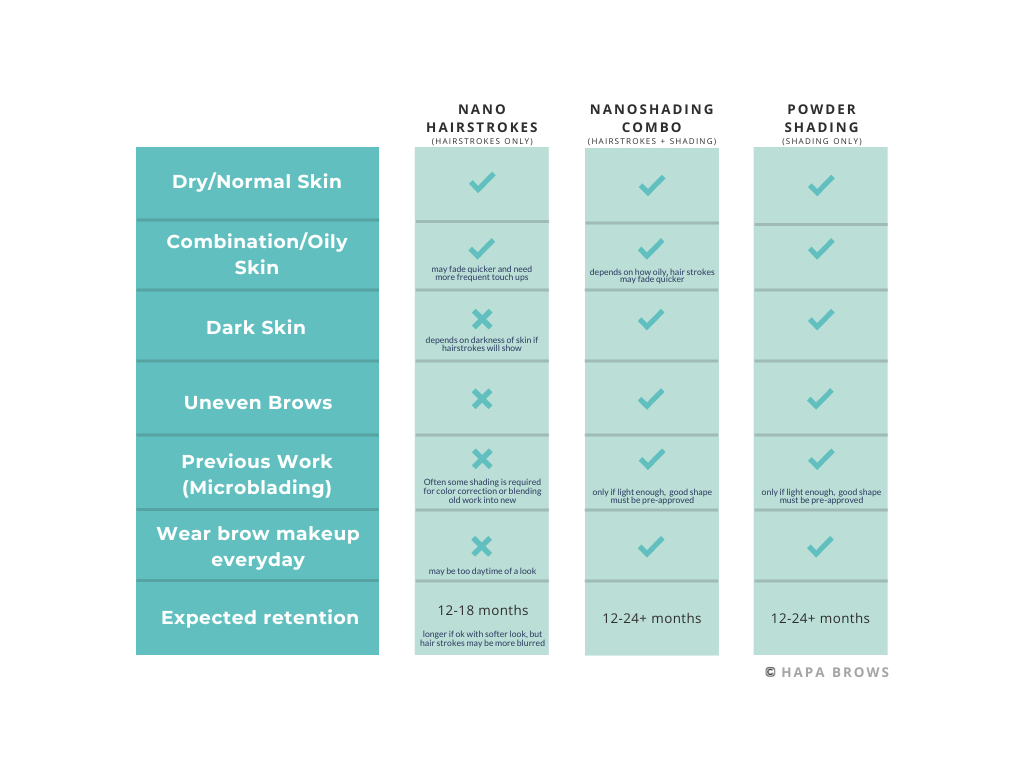
Most clients report little to no pain, and would compare it to a tweezing or threading session. Some clients even fall asleep! Topical anesthetic is applied prior to and during the procedure so the client feels comfortable while receiving the treatment. Anesthetics work better on some people than on others.
-
Pre-numbing: takes 10 minutes for numbing agents to penetrate skin since it is intact. To make client comfortable and take the edge off.
-
“First pass”: a very light pass with the permanent makeup machine to create the basic brow design. Most clients say their pain is 1-2 out of 10.
-
Secondary numbing gel is used, and works within 30 seconds. Because the skin is open or broken it is able to work quickly. Most clients say their pain is 0-1 out of 10 after the secondary numbing. It can be reapplied throughout the rest of the procedure for your comfort.
-
“Second pass”: I go over every stroke a second time to make make sure the machine hair strokes are dark enough and thick enough to match your natural hairs.
Initial session are 2.5-3 hours.
Your first appointment consists of a consultation prior to getting started, where we review your skin type, discuss your face and brow symmetry with a symmetry app, and discuss the different brow styles.
We then draw the outline shape by measuring your natural facial features to determine what compliments your face best. I use a symmetry app again to ensure everything is perfectly symmetrical. You approve the brow shape before continuing. Your input is valued during this process, its your face and not ours!
Once you approve the brow shape, pre-numbing is applied, and the actual procedure takes an 1-2 hours depending on the brow style. I show you how the brows are looking as I work so you can see the step-by- step process.
We then review aftercare and take “after” pictures!
Initial healing is 7-10 days. But don’t expect to see healed color/results until approximately 4 weeks after your appointment.
Day 1: Fresh brows look a little darker, crisper, and warmer than they will heal. You will be blotting your brows with a wet cotton round regularly throughout the day (every 30 minutes for the first 3 hours) and use a little ointment at night.
Day 2-5: A thin, flat scab forms on the brows. The thickness is comparable to a sunburn. They look darker and bolder because of the scab, similar to a “bold makeup” day. Don’t freak out, they won’t stay this dark!
Day 5-10: The scabs begin to flake off. The brows will seem patchy and be a little itchy. Use ointment as needed to help if they are dry or itchy.
Day 11-15 : The brows will look a lighter initially. The skin thickens slightly as it heals and because of this the pigment sits a little farther away from the surface of the skin and appears lighter. (Ex. think of when you get a cut and the scab falls off, you usually have a little white patch of skin where the new skin forms under the scab)
Day 16-30: Skin thins back out to normal, you will start to see more healed details and color will settle in.
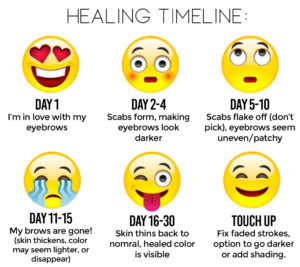
Examples of the Nanoshading Combo Healing Process:
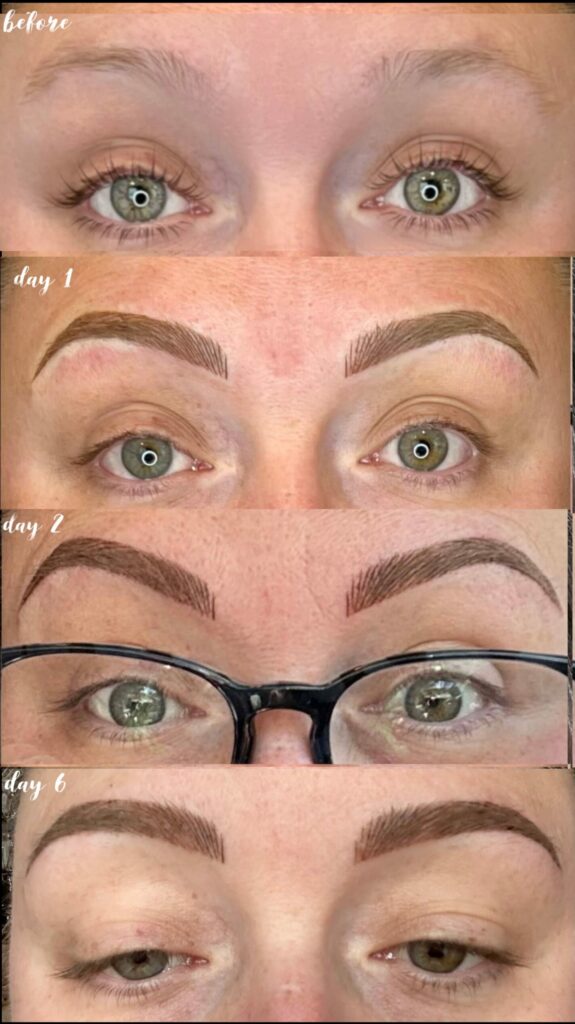
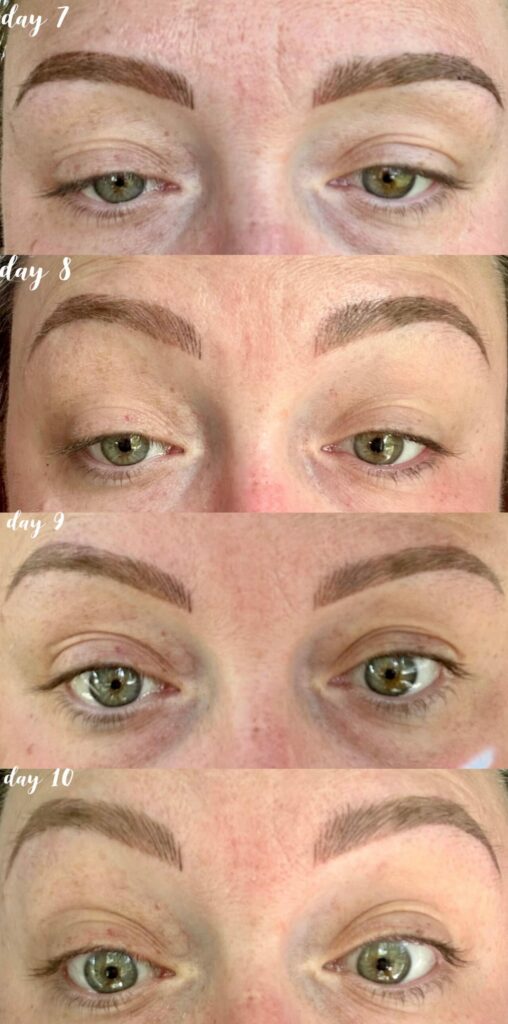
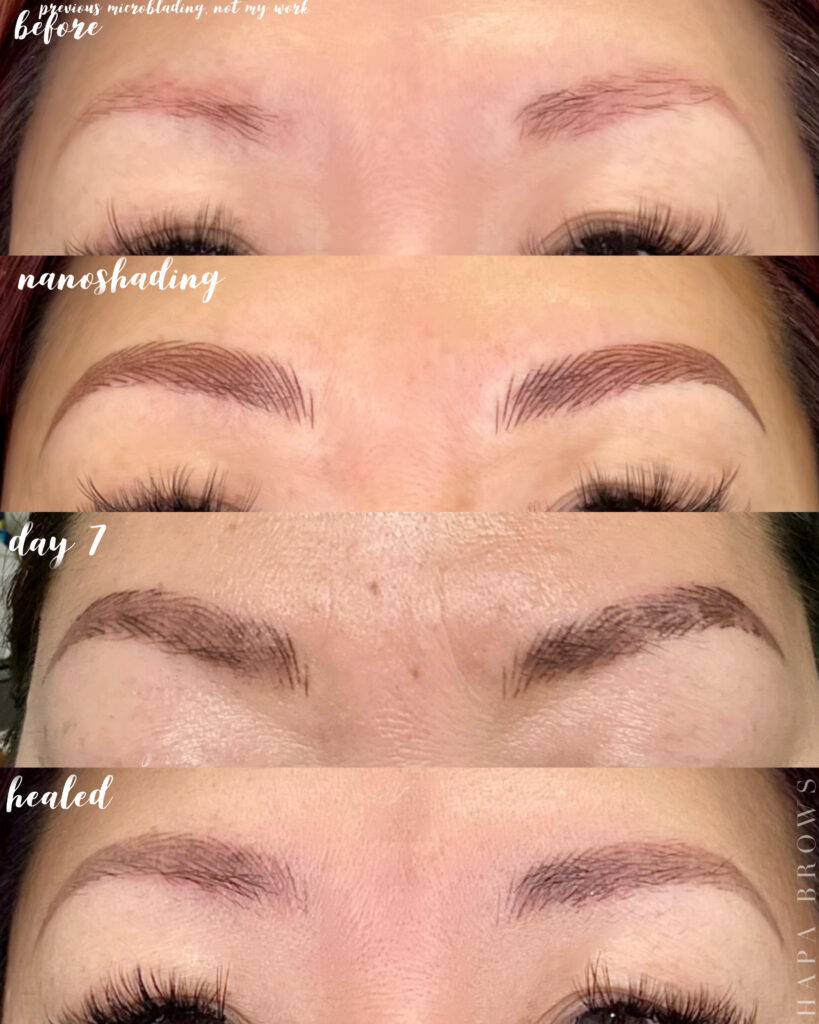
Our goal is to have every client enjoy at lease a year of great brows before they feel like they need to come back in for a touch up. If you don’t mind a softer look, you may be able to go longer in between touch ups. I tell clients to come back with the brow is 50% lighter and softer, or if you are starting to fill them in with brow makeup again regularly. It’s better to go longer in between touch ups, than come in too often and oversaturate the skin if it’s too soon.
Everyone’s skin is different, but generally combination/oily skin tends to fade and blur a little quicker. Services with shading also tend to hold their shape and color a little longer and better than Microblading alone.

Factors that can make your brows fade quicker:
- Oily skin – Natural oils in your skin both fade and blur the hairstrokes over time. Shading is recommended to help hold the shape for longer retention.
- Frequent exercise – The salt in sweat can purge the pigment from the skin.
- Sun exposure – The sun bleaches everything.
- Lighter pigment – Blondes fade faster than brunettes
- Certain medications
- Anti-aging skincare products – Retinol/Retin-A, Tretinoin, and Hydroquinone are just some skin care products that can increase skin cell turnover and lighten/fade pigments faster.
- Youth – Simply put, the younger/healthier you are, the faster your cells turn over
We recommend a touch up 4-8 weeks after your initial appointment.
The 4-8 week touch ups allow the artist to check how the pigment has healed under your skin. We can fix any faded strokes, go darker if the color has healed lighter than desired, or add shading if needed/wanted. Touch up appointments are often shorter than your initial session, lasting 1-2 hours.
Touch ups are optional. If your brows healed great, and you don’t see any patchy or lighter spots…great! I tell clients to just text me their healed brows to make sure everything looks good, and I am happy to cancel the 4-8 week touch up appointment, and plan to see you in a year or so when they start to fade. If they healed great, I’m not going to go over them again.
Following your initial touch up, most people have touch ups on a more annual-ish basis. Since everyone skin type, lifestyle, and preferences are different. It’s recommend to schedule an annual-ish touch up when your brows start to fade and feel lighter. I typically don’t do annual touch ups less that one year. I charge the same price if you come in 1 year later versus 3 years later, I don’t think you should be punished for brows that last longer! Touch ups 12+ months start at $300.
We also do not provide Permanent Makeup for people:
-Under 18 years old
-Are currently pregnant or breastfeeding
-Who have active skin conditions such as psoriasis, rosacea, eczema or severe acne on the area of treatment, or are prone to keloids.
-Who have autoimmune diseases. (dependent of type and medications, contact before booking)
-Ok with Permanent Makeup – Alopecia, Vitiligo, Celiac, Hashimoto, Graves
-Not eligible (must talk to doctor) – Lupus, Cronh’s, Rheumatoid Arthritis, Von Willebrand’s, Sjogren’s
-Who have HIV/Hepatitis, skin cancer, hemophilia
-Or if you are taking any immunosuppressant medications or blood thinners (daily).
Other Restrictions & Preparation
-Diabetes (requires doctor’s clearance)
-Chemotherapy (6 months after last treatment, requires doctor’s clearance)
-Accutane (must be off for 6 months prior to appointment)
-Retin-A/Rentiol (must be off 4 weeks prior to appointment
-Antibiotics or steroid medications (must not be on at time of appointment)
-Previous permanent makeup, must be light enough to work over (contact prior to booking)
-No botox, chemical peels 3-4 weeks before or after appointment
-24 hours before: no alcohol, caffeine, fish oil, or blood thinner (aspirin, ibuprofen)
-7-10 days AFTER appointment: no swimming, heavy sweating or exercising, or brow make
Permanent Makeup is technically considered a “tattoo” because pigment is deposited under the skin. However it is semi-permanent. While the pigment is permanently deposited under your skin, over time the appearance of the pigment will fade. Permanent makeup brows usually last between 12-24 months for most people, before it usually needs a touch up. If you don’t get a touch up, over time it will be a soft shadow. This can vary depending on the skin type (oily skin fades/blurs faster) and how you take care of the treated area.
The main difference between Permanent Makeup and traditional tattoos are:
1) Depth: Nano Hair strokes/Shading are more superficial than a traditional tattoo in order to achieve crisp hairlike strokes. Because of this Nano Hair Strokes are more susceptible to the natural oils in your skin and your skin cell turnover, both of which cause your brows to fade/lighten and blur over time.
2) Type of pigments used – The inks used for traditional tattoos often contain heavy metals which stabilize colors over long periods of time. Nano Hair Strokes/Shading pigments are not as long-lasting, and are formulated for more superficial depth and to softly fade over time.
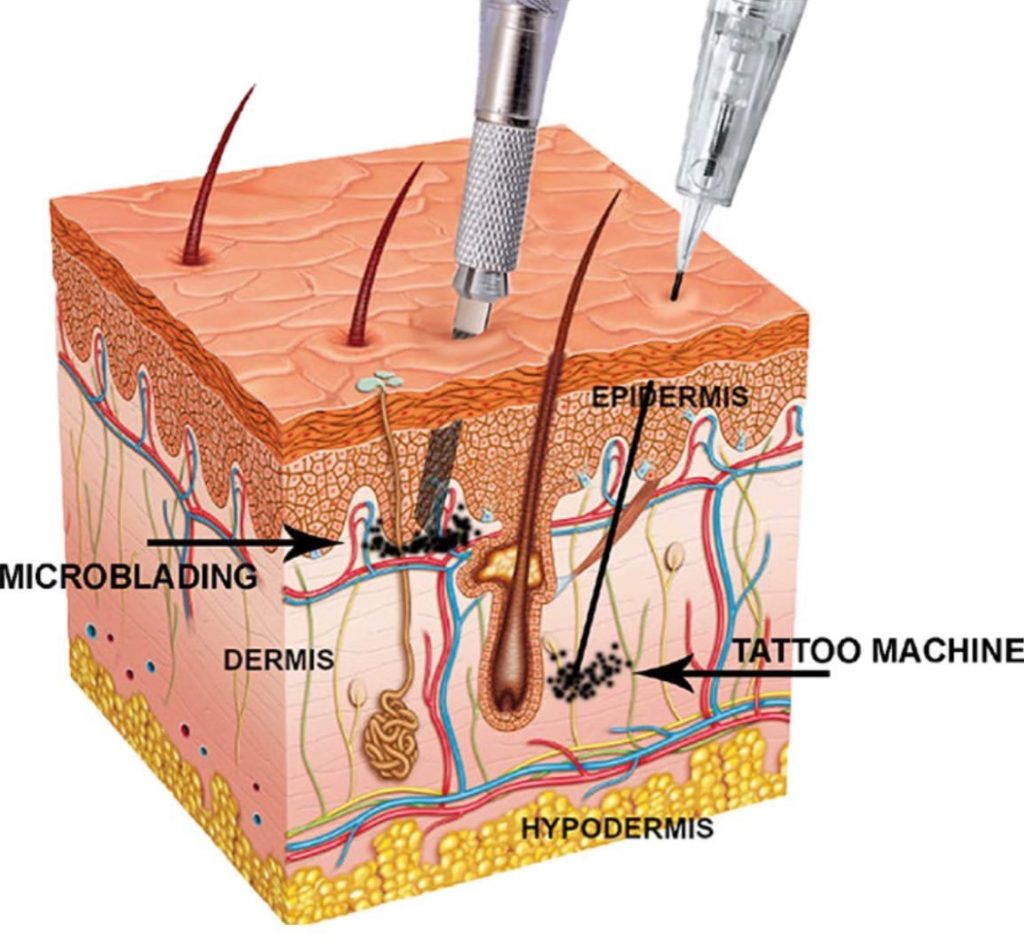
Our pigments are of the highest quality and are pre-mixed to match every type of hair color. We can mix in additional pigment colors to uniquely cater to each individual client, taking into account your undertones and brow style. We match the color of your eyebrow hairs and not your head hair color.
The Nano Hair Strokes color is matched to your natural eyebrow hair, not your head hair color.
During the consultation at the beginning of the appointment, we will look at various brow colors, both fresh and healed to get an idea of what color/darkness you prefer. I also show you as I am working, so you can see how the brow is progressing. Remember that the fresh brows lighten 10-20% in darkness, and cool down slightly in color. We are aiming for healed color, not fresh color!
There are two types of permanent makeup pigments: organic and inorganic. I will often use organic pigments for hair strokes and a combination of both for shading.
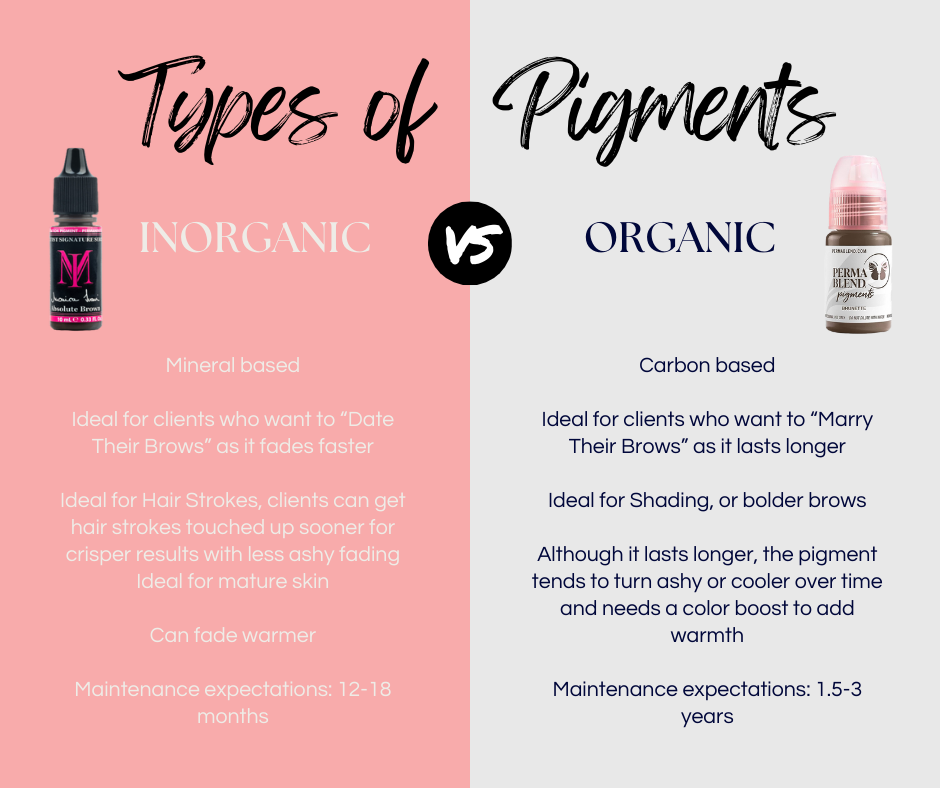
If you think about the color brown, its made up of a combination of the three primary colors- red, yellow, and blue. Permanent makeup colors are formulated with a combination of these colors, but some are more stable or long lasting than others.
Red Brows. If a brow turns red over time, the yellow and blue have faded and you’re left with red brows. This is more common with certain permanent makeup pigment lines. I don’t like pigment lines that fade red, because it can look very unnatural for most clients, since a small minority have reddish hair.
Blue Brows. This is common if you’ve had traditional tattoos for your brows. The darker the brown the more blue is in the ink. Often times the red and yellow fade and you’re left with blueish brows. Most traditional tattoos are too saturated to go over with permanent makeup without removal.
The pigments we use are high quality, and formulated for permanent makeup. With years of experience, and continued education, we pride ourselves on delivering beautiful brows that won’t fade funky colors over time. If you do have previous work that has faded warm or cool over time, we can offer color correction if the brows are not too dark.